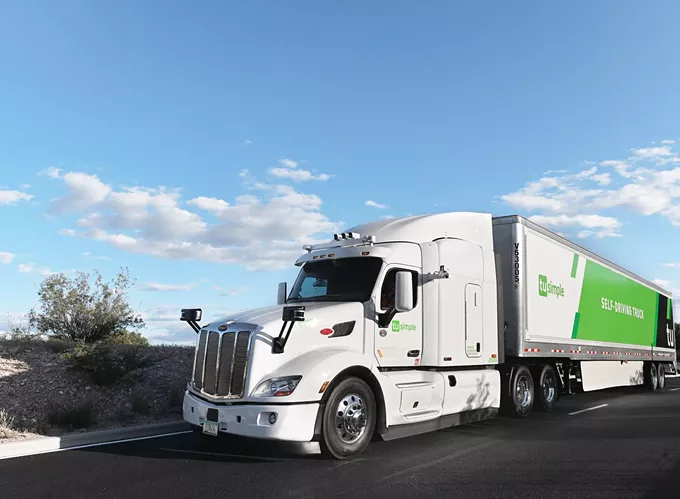On December 22, 2021, a semi-truck drove the I-10 from Tucson to Casa Grande without any humans on board. This trip was the culmination of years of road tests for the autonomous trucking company TuSimple, which plans to operate an eventual fleet of thousands of self-driving semis beginning in 2024.
TuSimple’s trucks have already conducted multiple trips between Tucson and Phoenix, as well as into Texas and Florida. However, these trips have always included two humans on board, even if they weren’t steering. The Dec. 22 trip, which was an 80-mile run between the Port of Tucson and a retail distribution center, was the first of TuSimple’s “driver out” tests. And more are on their way.
“Last year we were so focused on getting this driver-out test, and there was a lot of pressure to get it done, so it was really exciting to get it done before the holidays and start 2022 off on the right foot,” said Jason Wallace, director of marketing for TuSimple. “There’s a lot of moving parts. We have to work with the Arizona [Department of Transportation] and law enforcement. Although it is on the open road, it is supervised by law enforcement and it’s not something we can do anytime we want. It has to be well-orchestrated.”
During the driver-out trip (also codenamed “Ghost Rider”), the autonomous truck was accompanied by three other vehicles. The caravan comprised another TuSimple truck with humans on-board some five miles in front to watch out for irregularities on the road, a TuSimple van a half-mile behind the autonomous truck, and finally an unmarked law enforcement vehicle at the back.
The drive took place at night, both due to reduced traffic, and according to Wallace, for an added challenge.
“If you do this test during the day, I don’t know if it’s assumed you can do it at night. But our feeling was if you do it at night, it’s assumed you can do it during the day,” Wallace said. “We felt the AI system had to be at a very mature state before we removed the driver from the cockpit. The system had to be capable of surface streets, highways, lane changes, cut-ins, emergency vehicles, on ramps and off ramps and more.”
TuSimple plans to continue these trips through the first half of 2022 on a monthly basis. However, there are still a number of tests and advancements needed for the technology.
“There’s still a lot of challenges to overcome in this field,” said Hao Xin, a University of Arizona professor of electrical and computer engineering, and co-founder of the automotive radar company LuneWave. “One of them is perception: How are you going to be able to provide better-than-human perception in these systems? That’s a big thing we’re working on [at LuneWave]. There’s also control within the self-driving algorithm. But beyond science and engineering, there’s work that needs to be done in policy and regulation.”
Tucson-based LuneWave develops automotive radar sensor systems for autonomous vehicles. Their specialty antennas provide a 360 degree field of view, and can see nearly 1,000 feet in the distance. Because LuneWave’s sensors also view in 3D, they can be useful for autonomous drones as well as cars.
“I think a big reason there is so much of this in Tucson is that the state of Arizona is advanced and progressive in terms of policy and encouraging companies,” Xin said. “And once you start to have a cluster of these types of companies, more companies come in. It’s a positive feedback effect.”
LuneWave has also been conducting road tests throughout Tucson for multiple years, retrofitting vehicles with their “sensor suites” that utilize radar, cameras, and LIDAR. Xin has personally seen how this technology can make for safer and more efficient roads.
“Most traffic accidents are caused by human error,” Xin said. “So assisted driving and eventually autonomous driving will be very beneficial for avoiding this, and I think it’s actually a hugely underestimated part of the field.”
While this technology may eventually threaten job security for truckers, it can also solve current problems in the industry. In 2017, the American Trucking Association reported the trucking industry was short roughly 50,000 drivers. Estimates also include the shortage growing to more than 175,000 by 2026. ATA blamed these shortages on an aging driver population, lifestyle issues, and regulatory challenges.
“This on-demand economy that we’re living in and all enjoy, where you can order something online and have it delivered tomorrow, is placing extreme strain on the supply chain in general, even outside of COVID,” Wallace said. “The pandemic has exacerbated the issue, but these consumer behaviors are driving the need for the supply chain to become more efficient. There’s a really high demand for this technology.”
TuSimple’s next goals include being able to operate in cold weather, and automating multiple “lanes.” By lanes, the company is referring to one point to another. The Dec. 22 trip was to a single destination. However, the company plans to have their self-driving trucks be able to pick up freight and drive between multiple cities all without humans on board.
“The entire supply chain for this technology is still relatively young. So it’s really important for us to continue to work with manufacturers and developers to help evolve the supply chain as a whole,” Wallace said.
Although the self-driving semi-trucks are TuSimple’s most tangible endeavor, Wallace says they are “fundamentally a software company.” To this end, TuSimple recently announced a new collaboration with computer and microchip company Nvidia. In this partnership, TuSimple and Nvidia are co-developing the “computational brain” of the trucks’ computers.
“We’re no longer 100% reliant on suppliers to create the hardware for our system,” Wallace said. “We’re now involved in co-developing the brain. And that’s a huge step for us because it will make sure the hardware meets the demands of our software. In a sense, we’re in control of our own destiny.”


